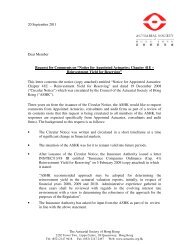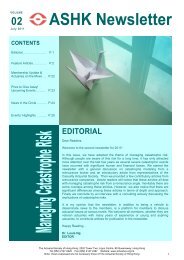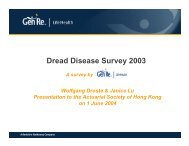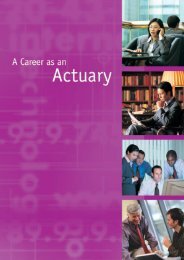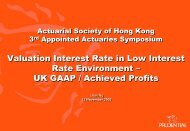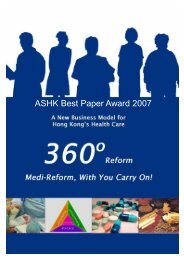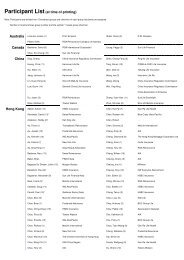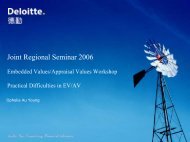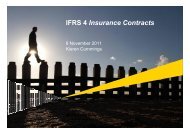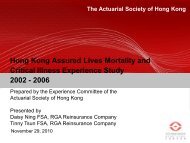Newsletter-volume 4 - 2011 (Draft) - Actuarial Society of Hong Kong
Newsletter-volume 4 - 2011 (Draft) - Actuarial Society of Hong Kong
Newsletter-volume 4 - 2011 (Draft) - Actuarial Society of Hong Kong
- No tags were found...
You also want an ePaper? Increase the reach of your titles
YUMPU automatically turns print PDFs into web optimized ePapers that Google loves.
BootstrappingThe bootstrapping method is a simulation approach which is also based on the chain ladder method. Eachsimulation represents a possibility <strong>of</strong> the future outcome. Based on the idea <strong>of</strong> chain ladder projection, theactual loss data can be divided into an “expected” component and a “noisy” component, i.e. the expectedclaims experience and the deviation from this average. In each simulation, the noisy components are resampledto recombine with the expected component to create a replica <strong>of</strong> the actual loss data. Thisreplica loss data triangle is different from the actual one, but has the same statistical property as the actualloss data. The replica claims triangle is used to project the reserves using the chain ladder method. Alarge number is simulated with each simulation producing a replica <strong>of</strong> claims triangle and a reserveoutcome. All the simulated reserves outcomes are then taken together to form a distribution <strong>of</strong> the reserve.Separation <strong>of</strong> actual loss data into an “expected” component and a “noisy” component.ActualclaimsExpectedclaims= +NoiseIn each simulation, the noisy components are re-sampled to recombine with the expected componentand the reserve is projected.ExpectedclaimsSamplednoise+ =ReplicaclaimsReservesDevelopment factorsUsing this approach, the risk margin is typically termed as the additional amount <strong>of</strong> reserves on top <strong>of</strong> thebest estimate such that the reserves are sufficient to cover the future claims with a reasonably highprobability. For example if 10,000 simulations are ran and sorted from lowest to highest, it is possible toobtain the risk margin at 75% level <strong>of</strong> sufficiency by taking the 7500 th reserve amount in the list. This isbecause 75% (7500/10000) <strong>of</strong> the possible scenarios have a reserve lower than this amount. Subtractingfrom it the best estimate reserves gives the risk margin.Cost-<strong>of</strong>-capital methodThis method originates from the concept that capital is required to support the run <strong>of</strong>f <strong>of</strong> insuranceliabilities. This is because in the event that the best estimate reserves are insufficient, additional money isrequired to pay <strong>of</strong>f the liabilities. In order for capital providers to absorb this risk, they would require areturn above the risk free rate on their capital supporting the liabilities. The risk margin is defined as thepresent value <strong>of</strong> this stream <strong>of</strong> required return.Risk margin by countryMost existing and proposed frameworks treat the risk margin as a component <strong>of</strong> insurance liabilities that isestablished in addition to best estimate reserves. The risk margin is usually calculated using either thepercentile method or the cost <strong>of</strong> capital method. The following table summarises the risk marginmethodology for some countries:The <strong>Actuarial</strong> <strong>Society</strong> <strong>of</strong> <strong>Hong</strong> <strong>Kong</strong>, 2202 Tower Two, Lippo Centre, 89 Queensway, <strong>Hong</strong> <strong>Kong</strong>Tel (852) 2147 9420 Fax (852) 2147 2497 Website: www.actuaries.org.hkNote: Views expressed are not necessary those <strong>of</strong> The <strong>Actuarial</strong> <strong>Society</strong> <strong>of</strong> <strong>Hong</strong> <strong>Kong</strong>14



